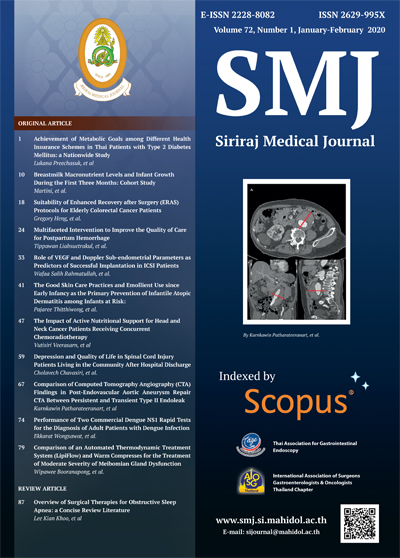The Impact of Active Nutritional Support for Head and Neck Cancer Patients Receiving Concurrent Chemoradiotherapy
DOI:
https://doi.org/10.33192/Smj.2020.07Keywords:
Head and neck cancer; radiotherapy; chemotherapy; chemoradiotherapy; nutrition.Abstract
Objective: Malnutrition is the most common problem in head and neck cancer (HNC) patients receiving concurrent chemoradiotherapy. The radiation toxicities cause decreased food intake, with resultant severe weight loss and malnutrition. This study sought to determine whether an active nutrition improvement counseling program before and during concurrent chemoradiotherapy for HNC patients could increase the treatment completion rate without the interruptions caused by the side effects of chemoradiotherapy.
Methods: The findings of a prospective study of the effects of an active nutrition improvement program before and during concurrent chemoradiotherapy (study, n = 32) was compared with those of a retrospective chart review of HNC patients who had received definite or postoperative concurrent chemoradiotherapy (control, n = 80). The correlations between nutritional status and the number of treatment completions, number of tube feeding insertions during treatment, RTOG toxicity, nutritional status, and quality of life were obtained.
Results: There was no statistically significant difference between the concurrent chemoradiotherapy completion rates of both groups (p = 0.121; 95% CI, 0.226-1.188). The major cause of delayed or discontinued chemotherapy was oral mucositis. No significant differences were found in the tube feeding insertion rates and RTOG toxicities of both groups. However, the data showed a clinically significant difference in the concurrent chemoradiotherapy completion rate for the study group (56%), more than 15 percentage points higher than the control group’s rate (40%).
Conclusion: An active nutrition improvement program before and during concurrent chemoradiotherapy is clinically beneficial for HNC patients, providing a higher treatment completion rate than otherwise.
References
2. Chinswangwatanakul V, ed. Siriraj cancer registry 2016. Siriraj Cancer Center, Faculty of Medicine Siriraj Hospital, Mahidol University, Thailand. ISSN 00857-3840.
3. Unsal D, Mentes B, Akmansu M, Uner A, Oguz M, Pak Y. Evaluation of nutritional status in cancer patients receiving radiotherapy: a prospective study. Am J Clin Oncol 2006;29:183-8.
4. Langius JA, Bakker S, Rietveld DH, Kruizenga HM, Langendijk JA, Weijs PJ, et al. Critical weight loss is a major prognostic indicator for disease-specific survival in patients with head and neck cancer receiving radiotherapy. Br J Cancer 2013;109:1093-9.
5. Isenring EA, Capra S, Bauer JD. Nutrition intervention is beneficial in oncology outpatients receiving radiotherapy to the gastrointestinal or head and neck area. Br J Cancer 2004;91:447-52.
6. White JV, Guenter P, Jensen G, Malone A, Schofield M. Consensus statement: Academy of nutrition and dietetics and American society for parenteral and enteral nutrition: Characteristics recommended for the identification and documentation of adult malnutrition (undernutrition). J Parenter Enteral Nutr 2012;36:275-83.
7. O'Neill JP, Shaha AR. Nutrition management of patients with malignancies of the head and neck. Surg Clin North Am 2011;91:631-9.
8. Beaver MES, Matheny KE, Roberts DB, Myers JN. Predictors of weight loss during radiation therapy. Otolaryngology-Head and Neck Surgery 2001;125:645-8.
9. Kang WX, Li W, Huang SG, Dang Y, Gao H. Effects of nutritional intervention in head and neck patients undergoing radiotherapy: a prospective randomized clinical trial. Molecular and Clinical Oncology 2016;5:179-82.
10. Ravasco P, Monteiro-Grillo I, Marques Vidal P, Camilo ME. Impact of nutrition on outcome: a prospective randomized controlled trial in patients with head and neck cancer undergoing radiotherapy. Head Neck 2005;27:659-68.
11. Bahl M, Siu LL, Pond GR, Kim J, Tannock IF, Bayley A, et al. Tolerability of the Intergroup 0099 (INT 0099) regimen in locally advanced nasopharyngeal cancer with a focus on patients’ nutritional status. Int J Radiat Oncol Biol Phys 2004;60:1127-36.
12. Pramyothin P, Manyanont S, Trakarnsanga A, Petsuksiri J, Ithimakin S. A prospective study comparing prophylactic gastrostomy to nutritional counselling with a therapeutic feeding tube if required in head and neck cancer patients undergoing chemoradiotherapy in Thai real-world practice. J Hum Nutr Diet 2016;29:768-76.
13. Brown TE, Banks MD, Hughes BGM, Lin CY, Kenny LM, Bauer JD. Randomised controlled trial of early prophylactic feeding vs standard care in patients with head and neck cancer. BJC 2017;117:15-24.
14. Langius JA, Zandbergen MC, Eerenstein SE, van Tulder MW, Leemans CR, Kramer MH, et al. Effect of nutritional interventions on nutritional status, quality of life and mortality in patients with head and neck cancer receiving (chemo)radiotherapy: a systematic review. Clinical Nutrition 2013;32:671-8.
15. van der Linden NC, Kok A, Leermakers-Vermeer MJ, de Roos NM, de Bree R, van Cruijsen H, et al. Indications for enteral nutrition use and prophylactic percutaneous endoscopic gastrostomy placement in patients with head and neck cancer undergoing chemoradiotherapy. Nutr Clin Pract 2017;32:225-32.
16. Cady J. Nutritional support during radiotherapy for head and neck cancer: the role of prophylactic feeding tube placement. Clinical Journal of Oncology Nurse 2007;11:875-80.
Downloads
Published
How to Cite
Issue
Section
License
Authors who publish with this journal agree to the following conditions:
Copyright Transfer
In submitting a manuscript, the authors acknowledge that the work will become the copyrighted property of Siriraj Medical Journal upon publication.
License
Articles are licensed under a Creative Commons Attribution-NonCommercial-NoDerivatives 4.0 International License (CC BY-NC-ND 4.0). This license allows for the sharing of the work for non-commercial purposes with proper attribution to the authors and the journal. However, it does not permit modifications or the creation of derivative works.
Sharing and Access
Authors are encouraged to share their article on their personal or institutional websites and through other non-commercial platforms. Doing so can increase readership and citations.















